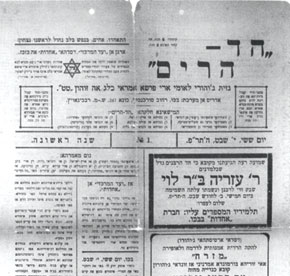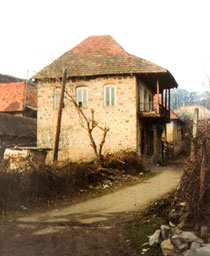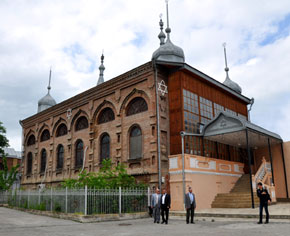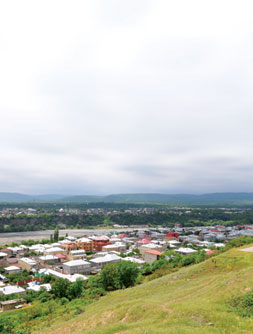 Pages 44-47
Pages 44-47By Karim Shukurov
The Jewish Diaspora: the history of its emergence and its characteristics
The Jews are originally from Mesopotamia. They moved to Palestine in approximately the 13th century B.C.E. They called themselves Hebrews – ‘crossing’ (those who crossed the river, i.e. the Euphrates). And Palestine is one of the centres of ancient civilization. Semitic tribes called the Canaanites dwelled there before the arrival of the Jews, who first lived in relations of kinship and tribe before a Jewish government evolved. The kings Saul (11th century B.C.E.), David (1000-965 B.C.E.) and Solomon (965-926 B.C.E.) ruled a united kingdom of Israel. In 926 B.C.E. the kingdom was divided into two parts – the kingdom of Israel (with its capital in Samaria) in the north and the kingdom of Judah in the south. These two kingdoms embarked upon different historical paths. Israel (926-722 B.C.E.) achieved greater progress due to its advantageous geographical location. It was ruled by a succession of kings from different dynasties. However, internal disputes weakened the kingdom and it was destroyed in 722 B.C.E. by King Sargon II (722-705 B.C.E.) of the Assyrian Empire (2nd millennium – 605 B.C.E.). The Assyrian government deported part of the population of Israel and replaced them with people from other countries in its empire.
In contrast to Israel, the kingdom of Judah (925-586 B.C.E.) was ruled by a single dynasty descended from David. A temple was built in Jerusalem, the capital. King Hezekiah of Judah managed to preserve the kingdom against attack by King Sargon II in 722 B.C.E. at the cost of huge concessions (payment of tribute and yielding some territory). The kingdom of Judah outlived that of Israel by 140 years. Even though the collapse of Assyria strengthened Judah, a new threat – the Babylonian Empire (beginning of the 2nd millennium – 539 B.C.E.) - did not allow complete independence. King Nebuchadnezzar II (605-562 B.C.E.) captured Jerusalem in 586 B.C.E. 10 per cent of the population, mainly craftsmen and the nobility, were moved to Babylon. So began the Babylonian bondage, which lasted until 539 B.C.E. In that year, King Cyrus II (558-530 B.C.E.), ruler of the Achaemenid Empire (550-330 B.C.E.), captured Babylon and allowed the displaced Jewish people to return to their land. In later eras the lands inhabited by Jews were tied closely to the fortunes of the Achaemenid, Seleucid (312-64 B.C.E.) and Roman (8th-5th centuries B.C.E.) Empires, and other states.
Even though there had been earlier Jewish resettlements, the emergence of the diaspora is related to the Babylonian bondage.
The collapse of the kingdom of Judah and bondage in Babylon resulted in a new stage in Jewish life and new ideological trend – the prophet movement. Monotheism, and everything related to it, was the idea underlying this movement. The Old Testament was the holy book of Judaism. It was Judaism that became the main identifying factor for Jewry, preventing the assimilation of the Jewish Diaspora and playing the main role in maintaining Jewish existence.
The Jewish Diaspora of Azerbaijan: its emergence and structure
When did Jews first connect with Azerbaijan? An Azerbaijani researcher, Muhammadhasan Valili (Baharli) in his book Azerbaijan, a Natural-Geographic, Ethnographic and Economic View, published in Baku in 1921, answered this question as follows:
Azerbaijani Jews are descendants of the ancient Jews captured by Assyrian rulers and settled first in Assyria, then in Media… From those places, after the collapse of the Assyrian Empire during the reign of King Shalmaneser (720 years before Christ and 1342 years before Muhammad) Jews moved to the territories of modern Azerbaijan, Georgia and Dagestan.
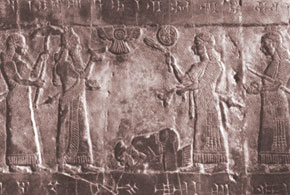 Assyrian king receiving tribute from Israel. Relief from the Black Obelisk of Nimrud. 825 B.C.E. British Museum
Assyrian king receiving tribute from Israel. Relief from the Black Obelisk of Nimrud. 825 B.C.E. British Museum There are also theories relating the emergence of the Azerbaijani Jewish Diaspora to the times of the Achaemenids. In any case, it is clear that the Jewish Diaspora in Azerbaijan was one of the first in the world. In Azerbaijan the ethnic group is referred to as juhud or yehudi.
Many changes have taken place within the Azerbaijani Jewish Diaspora over its long history. One of the most ancient Jewish groups is that of the Mountain Jews. They are so named for settling initially in the mountainous regions.
Mountain Jewish settlement in Azerbaijan was the result of both enforced and voluntary migrations. The first resettlements happened within the Sassanid Empire (3rd - 7th centuries). The Sassanids, in order to strengthen the defences of their territories along the Caspian Sea, resettled people, including Jews, from different parts of the country to coastal areas. This process continued during the Arab Caliphate (7th- 9th centuries), Mongols (13th - 14th centuries), and in later times. Rubruk, in his 13th century journey to Shirvan, referred to Jews in the region. Changes of centres and rulers also influenced the situation. The second great wave of resettlement took place under Safavid rule (1501-1736), in the reign of Shah Abbas (1587-1629). The main changes to the internal settlement of the Mountain Jews occurred during the reign of Shah Nadir Afshar (1736-1747), who put an end to the Safavid Empire and assumed power himself. In the times of Shah Nadir, Jews were living in Chirag Gala. The villages Juhudlar and Juhudkend indicate Jewish settlement in those places.
During Nadir’s attack, the Jewish settlement on the left bank of the river Gudyal was terminated.
With the death of Shah Nadir in 1747, the Afshar government collapsed and khanates emerged. The founder of the new Quba khanate, Huseyngulu Khan (1747-1758) allowed Jews to settle in a place a little below their former home. A new Jewish settlement appeared there. The reign of Fatali Khan (1758-1789), the son of Huseygulu Khan, saw population resettlements to the Quba Khanate continue. Jews were also among the populations resettled from Southern Azerbaijan and Gilan. As a result of these movements, new settlements emerge in Quba, as well as in other regions. In the early 19th century, the Russian Empire began to occupy northern regions of Azerbaijan. In the years 1804-1813 and 1826-1828, following the Russian – Iranian wars, Azerbaijani lands were divided. The northern territories of Azerbaijan, including their Jewish settlements, became part of the Russian Empire. The situation of the Mountain Jews within the Russian Empire soon became clear from the attitudes adopted towards them.
Poland had one of the highest Jewish population densities in Europe. However, during the land distributions (1772, 1793, 1795) which took place during the reign of Catherine II (1762-1796), some of the Jewish settlements in Poland became part of the Russian Empire. Restrictive actions were taken against Jews by the Russian government. In 1791 the ‘Beyond the Pale’ law was passed (a law prohibiting Jews from living outside set borders). This law was not applied to the newly occupied territories of Azerbaijan. However, by this law the Russian Empire demonstrated the main principles of its political approach to Jews. The derogatory slur jid (kike) was applied to Azerbaijani Jews, their ethnic origin was distorted, they were called Tats etc.
With the Russian occupation, there were changes to the dwelling places of Jews. They lived mainly in Kulgat in Quba; Vartashen (modern Oghuz) in Sheki; Shamakha in Shirvan, and places called Muju and Muju-Haftaran. In 1859 Baku became the provincial centre and, as a result, the number of Mountain Jews in Baku increased.
In the first reference books of the Russian government concerning the Caucasus (1823) it is written that jids (kikes) who lived in the village of Kulgat, before Quba, followed their own rules. They had four rabbis and four synagogues. The editor of the Caucasus Statistics Committee wrote in 1870 that Jews lived in the village of Muju in Shamakha district, Baku province. They lived in 145 yards, and in total, both sexes, there were 1,065 Jews. In Quba district they lived in a separate settlement Kulgat (in Russian, Sloboda), and numbered 4,390 in total, both sexes.
According to the 1869 report of the military governor of Baku, they totalled 6,046, both sexes (6,163 in 1848).
The editor mentions, from other sources, 10 rabbis, 10 synagogues, 20 schools and 952 houses in Quba, 3 rabbis, 1 synagogue, 2 schools and 145 yards in the village of Muju. At the end of the 19th century, large numbers of people moved from Quba and Sloboda to Baku. In the same period, Jews were part of the population of the village of Vartashen in Sheki district.
Political events in the Russian Empire in the early 20th century (the revolution of 1905-1907, the February revolution of 1917) affected numbers of Mountain Jews. During the Azerbaijan Democratic Republic there were efforts to unite Jews. According to the All-Union Population Census in 1926, after the establishment of the Soviet regime in Azerbaijan, there were 10,270 Mountain Jews (4,999 male and 5,271 female) in Azerbaijan.
Other Jewish groups present on the ethnic map of Azerbaijan, are Karaims and Krimchaks. Karaims are genealogically related to Khazars. There were close relations between Azerbaijan and the Khazar Khaganate (mid 7th century – late 10th century). After the Khaganate collapsed, some Khazars remained in Crimea.
Krimchaks are also related to the Jewish population of Crimea. Both Karaims and Krimchaks speak Turkic languages. The arrival of Karaims and Krimchaks in Azerbaijan was the result of marches by the Crimean Khanate to Azerbaijan, and relations between Azerbaijan and Crimea after Russian occupation. Very few Krimchaks (2 persons) and Karaims (18 persons) were registered during the All-Union Population Census of 1926.
Chronologically, the next Jewish group to settle in Azerbaijan were Kurdistan Jews – Lakhlukhs. Their arrival in Azerbaijan was a result of the Russian – Iranian wars of 1826-1828 and enforced resettlements after those wars. After the Mountain Jews, the most numerous in Azerbaijan are the European Jews – Ashkenazi. They mainly arrived from the ‘Pale of Settlement’ in Russia and also from other European countries. The first appearance of Ashkenazi can be attributed to the Imperial policy of resettling sectarians in the 1830s. Later arrivals increased when Baku became a centre of trade and industry. The number of Jews in Baku increased in line with growth in the total population. According to the All-Union Population Census of 1926 there were a total of 20,578 Jews (10,048 male, 10,530 female).
There are also Sephardis within the Jewish population in Azerbaijan. Sephardis are descendants of Jews who settled in Spain in the Middle Ages. Their arrival in Baku was associated with the progress of trade and industry in the city. The emergence of Georgian Jews coincided historically with the arrival of Mountain Jews. They spoke Georgian, lived in particular sections of Georgian cities and villages, and worked mainly in trade. Some Georgian Jews moved to Baku at the turn of the 20th century. According to the All-Union Population Census of 1926 there were 427 (210 males, 217 females) Georgian Jews in Baku.
Central Asian (Bukharan) Jews are also found in Azerbaijan, although in small numbers. Their appearance in Azerbaijan was also associated with trade and industrial progress. According to the All-Union Population Census of 1926 there were 48 (31 male, 17 female) Central Asian Jews here.
At the end of the 1930s a process of ‘uniting’ ethnic groups began in the field of ethnic relations in the USSR. Groups of Azerbaijani Jews were ‘abridged’. In the last population census, taken in 1989 on the eve of the USSR’s collapse, there were 30,594 Jews in Azerbaijan; 5,404 of them were Mountain Jews. Currently Mountain, Ashkenazi and Georgian Jewish communities are represented in Azerbaijan.
The treatment of Jews in Azerbaijan and Jewish attitudes towards the country.
Facts covering nearly three hundred years allow us to make clear inferences on these questions. The history may be divided into periods:
The death of Shah Nadir and the khanate era (1747 – early 19th century). The policies of Huseyngulu Khan of Quba and his son Fatali Khan, saw the Mountain Jews united again with a stable settlement (Kulgat – Jewish Sloboda – the Red District) (it would perhaps be more suitable to restore the historical name of Red District, which was Jewish Sloboda).
Occupations by the Russian Empire and the period of bondage (early 19th century – October 1917). During this period the treatment of Jews was determined by Tsarist Russia. The application of the ‘Pale of Settlement’ and restrictive actions against Jews continued throughout this time. However, not only were there no massacres of Jews in Azerbaijan, as there were in western parts of Russian (Chisinau in 1903, Odessa in 1905, Belostok in 1906 etc.), but particular conditions emerged for economic and religious-cultural development.
The struggle for independence in Azerbaijan (October 1917 – May 1918). Azerbaijani Jews were part of the independence struggle in Azerbaijan. They stood alongside their Azerbaijani neighbours and incurred heavy losses during the massacres carried out by Armenians in March 1918.
The Azerbaijan Democratic Republic (1918 - 1920). This period was an important one in the history of Azerbaijani Jews. The law creating the independent Azerbaijani parliament reserved a place in it for the Jewish National Council. During the two-year life of the government, Jews occupied ministerial, vice-ministerial and other posts. The Jewish National Council was recognized as the representative of all Jews etc.
The Azerbaijani SSR (1920 - 1991). During this period, the treatment of Jews was governed by the policies of the Soviet government, however positive exceptions were observed in Azerbaijan, as a result of the traditional attitudes that had developed towards Jews. During the establishment of Bolshevik government in Russia (October 1917) Jews occupied decisive positions in the political leadership. One third of the Central Committee of the Russian Communist (Bolshevik) Party was Jewish. 4 of the 6 members of the All-Russian Central Executive Committee Presidium elected on 26 October 1917 were Jewish. These facts gave rise to pejorative slogans: ‘Jewish revolution’ and ‘Jewish domination’. As a result, an anti-Jewish faction emerged within the upper echelons of the Party. The establishment of Soviet rule in Azerbaijan and strengthened Armenian-Russian control of the Azerbaijani political environment created obstacles for Jews. In fact, Azerbaijani Jews, particularly the elite, drew clear conclusions about the political climate of the day. Instead of strengthening their position in the political leadership, they preferred to work for success in economic and socio-cultural spheres. It may well be that this approach saved them from greater harm. When Jews were allowed to leave the USSR in the 1970s, a few thousand also left the Azerbaijan SSR.
Modern Azerbaijan (since 1991). Azerbaijani Jews were side-by-side with the Azerbaijani people in the struggles for independence, its achievement and its consolidation. It was no accident that Jewish sons were among those who fell on 20 January 1990 and those who were killed in the war for the integrity of Karabakh. Azerbaijani Jews are represented in all aspects of life in Azerbaijan and play a huge role in Azerbaijan’s participation in Judaism and Jewish events world-wide, as well as in the further development of relations between Azerbaijan and Israel. The country’s benevolent policies towards its historically-formed Jewish population are being continued. The vitality of the 2,500-year old Azerbaijani Jewish Diaspora has only been possible thanks to this unity.
Further reading.
The Azerbaijan Democratic Republic (1918-1920). Parliament (Stenographic statement) Volume I. Baku, 1998
Javadov G. Tats // in the book Indigenous and Ethnic Minorities of Azerbaijan. Baku, 2000, pages 67-106
Guliyeva N. The Family Life and Spiritual Culture of Azerbaijani Tats. Baku, 2005
Valili M. Azerbaijan, a Natural-Geographic, Ethnographic and Economic View. Baku, 1993
Agarunov M., Guseynov R, Karimov E. The Mountain Jews of Azerbaijan. A Bibliographical Index. Baku, 2000
Agarunov Y.M. The Great Destiny of a Small Nation. 1995
Bekker M. The Jews of Azerbaijan: History and Contemporaneity. Baku, 2000
All-Union Population Census of 1926. Volume XIV TSFSR. Nationality – Native Language – Age – Literacy. 1929
Mikdash-Shamailova, Dr.L.A. (compiler and editor) The History and Culture of Mountain Jews. Jerusalem – Quba, 2009
Kojinov V.V. The Truth about Stalin’s Repression. 2008
Miller B.V. Tats, Their Settlements and Dialects. 1929 issue VII, #8
Bronevsky, Semyon. (compiler and editor) The Latest Geographical and Historical Information on the Caucasus. 1823
Lists of Populated Places in the Russian Empire; The Caucasus. LXV, Baku province, Tiflis, 1870
About the author: Karim Shukurov Karim oglu is Head of Department at the ANAS Institute of History, Doctor of Historical Science. Author of books and articles on the historical demography of Azerbaijan and contemporary problems of Azerbaijani history. E-mail: kkshukurov@mail.ru
